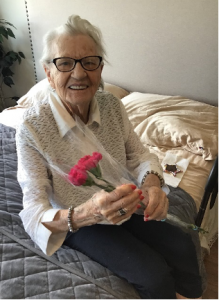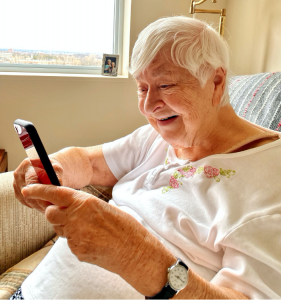
Finding ways to stay connected with people we care about is perhaps one of the most challenging aspects of life during COVID-19.
We are all social beings who thrive on contact with others and the best social contact is in person. But, we can’t do that right now – so how can we connect?
According to Dr. Frank Knoefel, a specialist in geriatric and memory care at Bruyère Continuing Care and Director of Dementia Care at All Seniors’ Care, Ottawa, there is no one size fits all solution. “Dementia is a unique experience”, he says, “it is a reversal of our life’s learnings”. As such, the mode of communication must be customized depending on where your loved on is in the disease process.
He recommends using the following hierarchy when connecting with a loved one who has dementia:
- In person
- Visiting from outside the window
- Video call
- Telephone or audio-only call
With much of the country facing being told to limit contact with others outside their household, in person visits puts people with dementia and older people in general at risk. And, with winter coming, visiting from outside the window is quickly becoming impractical.
Why not try a video call?
In today’s technology driven world, there are an array of communication methods to help people with dementia keep in touch with family and friends. By bringing the world to the person’s home, video calls can capture attention more effectively than telephone, thereby helping maintain important relationships.
According to Dr. Knoefel video calls are a great choice, as long as the person with dementia is able to understands the very nature of a video call. “They have to understand that, once the video is turned off, the person does not remain inside the box! To minimise worry, it is essential that they know their loved one is safe at home after the call has ended”.
Also, before engaging a person with dementia in a video call, it’s important to assess whether they’ll recognize the person calling them.
The decline in facial recognition in dementia can be distressing for everyone involved. Since this lack of recognition can be caused by the family member not recognizing a particular version of their loved one, it’s essential to know where the person with dementia is in their timeline. For example, a mother may remember her daughter as a teenager, not an older adult. In these cases, Dr. Knoefel recommends that you “use a picture of yourself —at a time that they remember— as a placeholder picture during the call”.
Below are four helpful tips for making video calls with your loved one enjoyable and successful:
1. Plan ahead:
- Contact your loved one or their caregiver ahead of time. Ask about their access to technology, including what they are using and whether they require help or supervision. Then, set up the same or compatible technology and take it for a test drive the day before your scheduled call. This will help mitigate challenges and frustrations for both you and your loved one.
- To ensure the call goes smoothly, confirm contact details and instructions with the residence or caregiver ahead of time.
- Find a time when your loved one is most alert. This will set you both up for success. Morning tends to be the best time for people with dementia, especially if they experience sundowning in the evenings.
2. Be flexible:
- Introduce yourself to the person with dementia. It may be harder for your loved one to recognize you in this new virtual way, so identifying yourself right away helps to avoid confusion.
- The first call may not be as successful as you hope. That’s okay! Don’t be discouraged—simply try again after thinking of ways to improve the call.
- Remember that the use of new technology is not for everyone. If the calls continue to create confusion or agitation after a few attempts, it may not be the right mode of socialization.
3. Develop a video presence:
- Comfortable, warm eye contact conveys you are interested and that you care. To make “direct eye contact” virtually, look into the camera, not at the computer screen.
- Be aware of your body positioning, movement, facial gestures, voice quality and vocal tone. Face the computer screen, don’t move around quickly, and remain calm and approachable.
- Exaggerate motions such as nods and other actions so your loved one notices them and knows you are listening.
- Reflect back what you hear.
4. Set realistic expectations:
- People with dementia can be unpredictable with their emotions and behaviors, especially when they are tired or in pain.
- Try not to worry about the length of the call—it’s all about the connection you make during that time. Even a brief call can make a significant impact in preventing the damaging effects of social isolation for your loved one.
- Keep conversations light and focus on engagement. Use your knowledge of your loved one’s interests or life story to make the interaction joyful and appealing. Favorite songs, poems, anecdotes from the past, or watching their small grandchildren or pets during your video conversation could be the keys to successful communication.

Tips for Speaking Effectively on the Telephone
For many families, the primary means of contact is still the telephone. But when a senior is experiencing dementia, or even mild cognitive impairment, having a good phone conversation can become difficult. The once easy calls become quiet and one sided.
While there is no magic answer to having a fruitful call with someone with dementia or Alzheimer’s, there are ways to enhance the dialogue. It all begins with a plan.
What to do when your loved one has trouble speaking on the phone:
It’s important to keep in mind that, as dementia progresses, seniors become less able to focus and recognise people, let alone disembodied voices.
Call at the time of day that is best for them. Be prepared with topics. Try not to have rigid expectations, though. Listen well to what they say and follow their lead as much as possible.
Identify yourself: The person may recognize your voice but may not be able to match it to your name.
Keep it short: Limit phone calls to a minute or two and say something positive like, “I was thinking of you and just wanted to call and say hello.”
Keep it simple: Avoid open-ended questions. Ask direct questions: “Did you have a good lunch? I heard you ate chicken.”
It’s not uncommon for residents to just put the phone down in the middle of a conversation and wander off, leaving the family member hanging. Not being sure what’s going on can be unnerving.
More Communication Tips
Whether speaking on the telephone or virtually, keep these communication tips in mind:
- Speak slowly and clearly in a normal tone. Avoid using the higher register of your voice.
- Enunciate every word. This enables lip-reading for the hearing impaired and relieves any gaps in audio transmission.
- Use gestures to supplement your words
- Look for and respond to any cues the person is not following the conversation (e.g. asking you to repeat questions; hearing words incorrectly; appearing confused, distracted, or frustrated).
Most importantly, don’t correct, or question the validity of what your loved one says. Focus on what matters: that you love them and enjoy speaking with them.
Supporting Our Residents
To find out what our senior housing communities are doing to support our residents during this time, click on the link. Click here to learn about our latest news and events or visit our social media. You can also click here to learn more about assisted living options in Manitoba, senior care communities in Saskatoon, and our Winnipeg retirement communities.

Author: Julianna McLeod
